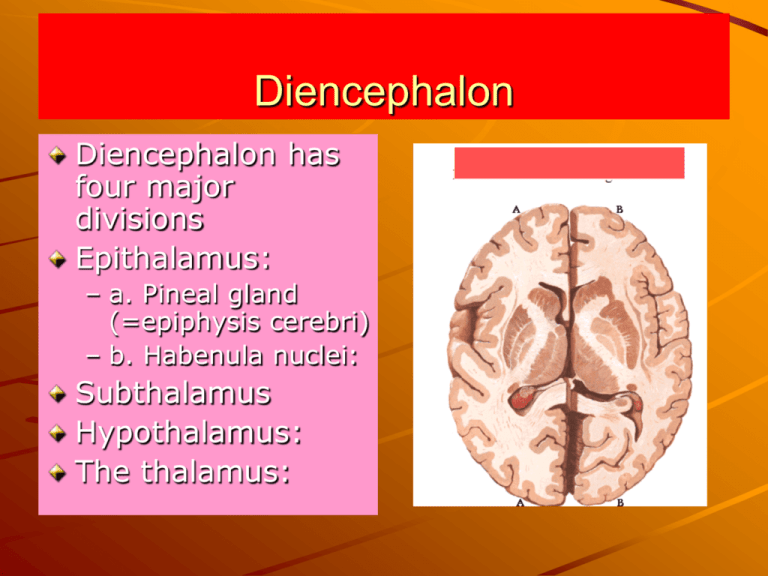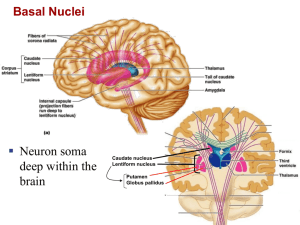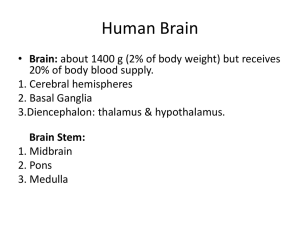Diencephalon
advertisement

Diencephalon Diencephalon has four major divisions Epithalamus: – a. Pineal gland (=epiphysis cerebri) – b. Habenula nuclei: Subthalamus Hypothalamus: The thalamus: Thalamus Greek word thalamos, meaning an inner room or storeroom of a Greek or Roman house Its nuclei are conventionally divided into groups based on their anatomical locations internal medullary lamina – This is a curved thin sheet of myelinated fibers. It divides most nuclei into medial and lateral groupings – Rostrally, the lamina bifurcates to enclose the anterior nucleus, which may be divided into smaller groupings (However, all of these subdivisions of the anterior nuclear complex have similar connections). Thalamus cont.. 1.Lateral Grouping: This is the bulk of the thalamus. This collection of nuclei is divided into a dorsal tier and a ventral tier. – a. Dorsal tier: Pulvinar, lateral posterior, and lateral dorsal nuclei. – b. Ventral tier: ventral anterior, ventral lateral, ventral posterior medial (VPM), ventroposterior lateral nuclei (VPL). 2. Medial Group: There is only one nucleus, the dorsal medial nucleus, 3. Medial and lateral geniculate bodies: – The nuclei are caudal extensions of the thalamus and receive auditory and visual inputs, respectively (Metathalamus) Intralaminar nuclei: The largest is the centromedian nucleus Thalamus Connections Thalamus Functional Subdivisions 1. Specific relay: These nuclei receive incoming sensory or motor information on its way to the cortex. – – – – a. Medial geniculate: audition b. Lateral geniculate: vision c. VPM/VPL: somatosensory d. VA/VL motor: cerebellum, basal ganglia to cortex (motor and premotor cortices). VL thalamectomy for Parkinson's disease helps reduce rigidity, but not tremor. This suggests that the VL is involved in the control of muscle tone. Thalamus Functional Subdivisions 2. Association: – a. Pulvinar/Lateral Posterior Complex – b. Lateral Dorsal (LD): – c. Dorsal medial (DM): 3. Nonspecific nuclei: – a. Part of VA: – b. Intralaminar: – i. Centromedian nucleus: – a . Reticular Nucleus Thalamic syndromes Tumors and especially vascular lesions related to the middle and posterior cerebral arteries may involve thalamus to some extent. A typical condition is known as thalamic pain syndrome, which is caused by destruction of the sensory relay nuclei in the posterior half of the thalamus. It is most often caused by occlusion of the thalamogeniculate branches of the posterior cerebral artery. In addition to injury of the internal capsule with transitory hemiparesis and homonymous hemianopsia, there is usually impairment of superficial sensation of the opposite side of the body. Position sense may be affected more frequently than other sensory systems. An agonizing concomitant of this syndrome is a burning or knife-like pain, which usually appears after several weeks or months when other sensory functions are beginning to return. Clinical Case A 45 year old woman started month earlier with sudden weakness and numbness down the whole of the left side. There was a family history of diabetes and high blood pressure. When examined locally she was weak and numb on the left side with chorea of the left arm. Over the next month her weakness and sensory loss improved but she developed an unpleasant burning sensation on the left side, which persisted. She also experienced two episodes of transient dizziness on head movements.









